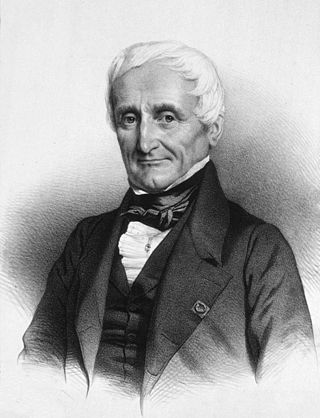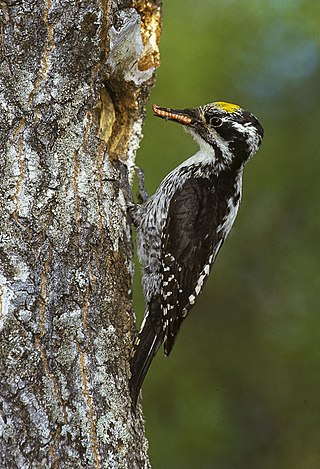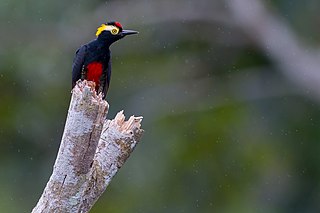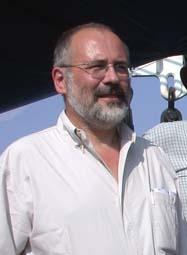
The black-backed woodpecker, also known as the Arctic three-toed woodpecker, is a medium-sized woodpecker inhabiting the forests of North America.

Bernard-Germain-Étienne de La Ville-sur-Illon, comte de Lacépède or La Cépède was a French naturalist and an active freemason. He is known for his contribution to the Comte de Buffon's great work, the Histoire Naturelle.

Louis Pierre Vieillot was a French ornithologist.

The African grey woodpecker is a species of bird in the woodpecker family Picidae. Is a widespread and frequently common resident breeder in much of Sub-Saharan and equatorial Africa. It is a species associated with forest and bush which nests in a tree hole, often in an oil palm, laying two to four eggs. It is a common bird with a very wide range, and the International Union for Conservation of Nature has rated its conservation status as being of "least concern".

The white-naped woodpecker is woodpecker which is a widespread but a scarce breeder in the Indian Subcontinent. It is associated with open forest and scrub with some trees. It nests in a tree hole, laying one or two white eggs.

André Marie Constant Duméril was a French zoologist. He was professor of anatomy at the Muséum national d'histoire naturelle from 1801 to 1812, when he became professor of herpetology and ichthyology. His son Auguste Duméril was also a zoologist, and the author citation Duméril is used for both André and his son.
Jacques Pucheran was a French zoologist born in Clairac. He was a grandnephew to physiologist Étienne Serres (1786-1868).

Picoides is a genus of woodpeckers that are native to Eurasia and North America, commonly known as three-toed woodpeckers.

The checkered woodpecker is a species of bird in subfamily Picinae of the woodpecker family Picidae. It is found in Argentina, Bolivia, Brazil, Paraguay, and Uruguay.

The red-necked woodpecker is a species of bird in subfamily Picinae of the woodpecker family Picidae. It is found in every mainland South American country except Argentina, Chile, Paraguay, and Uruguay.

The Nubian woodpecker is a species of bird in the family Picidae. It is distributed widely in Central and Eastern Africa, from Chad in west to Somalia in east and Tanzania in south. It is a fairly common species with a wide range, the population seems stable, and the International Union for Conservation of Nature has rated its conservation status as being of "least concern".

The ringed woodpecker is a species of bird in subfamily Picinae of the woodpecker family Picidae. It is found in every mainland South American country except Argentina, Chile, Paraguay, and Uruguay.

The spot-breasted woodpecker or spot-breasted flicker is a species of bird in subfamily Picinae of the woodpecker family Picidae. It is found in Panama and every mainland South American country except Argentina, Chile, Paraguay, and Uruguay.

The Sunda pygmy woodpecker, also known as the Sunda woodpecker, is a species of bird in the family Picidae. It is found in Brunei, Indonesia, Malaysia, and Singapore. Some taxonomic authorities continue to place this species in the genus Dendrocopos or Picoides.

The yellow-tufted woodpecker is a species of woodpecker. It is found in Bolivia, Brazil, Colombia, Ecuador, French Guiana, Guyana, Peru, Suriname, and Venezuela. Its natural habitats are subtropical or tropical moist lowland forests and heavily degraded former forest.

The olive woodpecker is a species of bird in the woodpecker family Picidae.

The yellow-throated woodpecker is a species of bird in subfamily Picinae of the woodpecker family Picidae. It is found in Bolivia, Brazil, Colombia, Ecuador, French Guiana, Guyana, Peru, Suriname and Venezuela.

Dutuitosaurus is a genus of metoposaurids, a group of amphibians that lived during the Late Triassic period. Dutuitosaurus was discovered in the early 1960s in Morocco and is known from the lower t5 units of the Timezgadiouine Formation exposures in the Argana Basin of the High Atlas Mountains and was first described in 1976 by French paleontologist Jean-Michel Dutuit. Material of Dutuitosaurus is currently held in the Muséum national d'histoire naturelle (MNHN) in Paris, France. It was originally placed within Metoposaurus as M. ouazzoui but was subsequently placed in its own genus, Dutuitosaurus, by Hunt (1993), who identified a number of differences between Metoposaurus and the Moroccan metoposaurids. Features that differentiate Dutuitosaurus from other metoposaurids include relative elongate intercentra and a maxilla that enters the orbit.

Theodore Wells Pietsch III is an American systematist and evolutionary biologist especially known for his studies of anglerfishes. Pietsch has described 72 species and 14 genera of fishes and published numerous scientific papers focusing on the relationships, evolutionary history, and functional morphology of teleosts, particularly deep-sea taxa. For this body of work, Pietsch was awarded the Robert H. Gibbs Jr. Memorial Award in Systematic Ichthyology by the American Society of Ichthyologists and Herpetologists in 2005. Pietsch has spent most of his career at the University of Washington in Seattle as a professor mentoring graduate students, teaching ichthyology to undergraduates, and curating the ichthyology collections of the UW Burke Museum of Natural History and Culture.

Philippe Bouchet is a French biologist whose primary scientific fields of study are malacology and taxonomy. He works at the Muséum National d'Histoire Naturelle in Paris. He is also a Commissioner of the International Commission on Zoological Nomenclature.


















